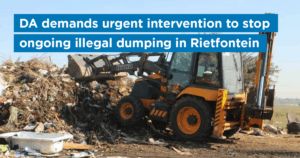The Gauteng Broadband Network (GBN) is facing a network failure with 70%, or 1.734 devices, having reached their end of service (EOS), which poses a high fault risk and increases the likelihood of network failures.
This information was revealed by the Gauteng MEC for e-Government, Bonginkosi Dhlamini in a written reply to the Democratic Alliance’s (DA’s) questions tabled in the Gauteng Provincial Legislature (GPL).
According to MEC Dhlamini, 26% of these devices are beyond their end-of-maintenance (EOM) phase. These devices will not be able to support future capacity demands, and the operational risk will only increase with time. The longer the upgrade is delayed, the more prone the network becomes to faults, breakdowns, and security vulnerabilities due to outdated hardware.
In addition, when asked about the estimated life span of the current Gauteng Provincial Network (GPN), the reply is even more startling, where it states that without any upgrades, the reply indicated five years; however, it is essential to note that a critical portion of the network, specifically the core equipment, will reach its end-of-life on December 31, 2024.
The network is speeding towards a cliff, and decisive action needs to be taken to prevent a failure in the network.
The December 2024 deadline for the core equipment refresh is critical. After this date, the network will face increased downtime and become costlier to maintain. If no upgrades are initiated before the EOL, the entire network infrastructure could face severe performance degradation, network bottlenecks, and an inability to scale for future government services.
Given the severity of the situation, two comprehensive assessments have been conducted to evaluate the network’s current state, and both highlight the critical need for enhancements.
Some of the findings of the GBN Network Assessment:
Ageing devices lack technical support, spare parts, and security features, increasing operational costs and making the network more vulnerable to breakdowns.
Expanding the bandwidth capacity from 1 G to 10G on the WAN Access Ring
Improving the overall network architecture by connecting access rings directly to the core routers using IP/MPLS protocols.
The estimated cost for this part of the upgrade is R300 million. The second assessment pertains to the GBN Dense Wavelength Division Multiplexing (DWDM) Network Upgrade Solution. Some of the findings are:
The DWDM network, which forms the backbone of the GBN, is also reaching its limits.
The network has been operating for over ten years and is experiencing performance degradation due to over 80% capacity usage.
Many core devices, such as the OptiX OSN 8800 and OSN 6800, will reach EOS by the end of 2024, further exacerbating the risk of failures.
The DWDM network upgrade aims to address these challenges by increasing fibre capacity from 40 wavelengths to 96 wavelengths per fibre and transitioning from 10G services to 100G services to handle the increasing traffic demands.
The estimated cost of these upgrades is R400 million.
The e-Government Department is taking proactive steps by preparing a formal submission for the Premier’s Budget Committee (PBC).
Immediate upgrades are needed to ensure the long-term sustainability of the network and to prevent network failures and service disruptions, which could significantly impact government operations and the public’s access to services.









